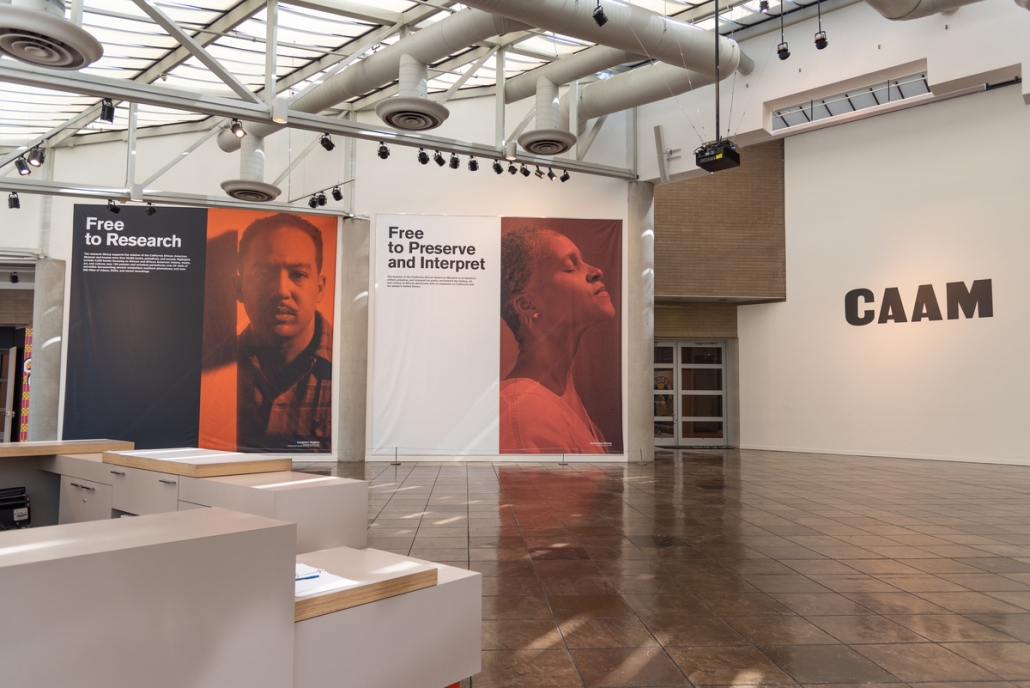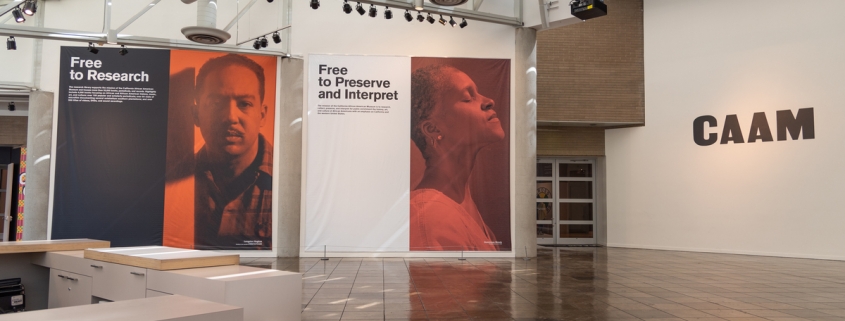Free To All: The California African American Museum showcases Black history

Located in Exposition Park, the California African American Museum stands in majesty.
The words “free admission” are printed in large font near the opening doors, letting everyone who passes by know one thing: The cultural content inside the museum is accessible to all.
That is something the CAAM has taken pride in ever since its official opening in 1981, offering a balance between art and history to it’s visitors. The museum has five galleries that rotate twice a year: two art, two history and one permanent collection.
Each exhibit has a life of its own. From “Dust My Broom: Southern Vernacular from the Permanent Collection” to “Making Mammy: A Caricature of Black Womanhood, 1840-1940,” every exhibit contains lively elements that engage viewers.
CAAM Executive Director George Davis made telling history with a more compelling, multimedia approach one of his objectives since joining the museum in 2015. Davis, who has a background in entertainment and broadcasting and received his MBA from USC in 1996, wanted to make the content more alluring to younger audience members.
“I just felt the need to shake it up quite a bit and that we needed to go much more Instagram, much more social media savvy and have programming that would really resonate and be relevant with [younger people],” Davis said.
To do this, the museum worked on a rebranding process that would make the institution more welcoming and relevant to youth.
“I just think that people [who are] younger just don’t want information that’s told the same way their parents receive information,” Davis said. “They still are concerned about the same kind of issues, but they just want to hear from people that they can relate to, and it could be older people, but they need to speak the right language.”
The museum is evolving its storytelling by displaying more contemporary art exhibits featuring younger artists, more visuals and videos in order to illuminate the rich history of the Black Californian community.

Currently, the CAAM has a lively exhibit named “Cross Colours: Black Fashion in the 20th Century.” The exhibit, curated by Tyree Boyd-Pates and Taylor Bythewood-Porter, pulls together contemporary art that showcases Black culture and Afrocentrism. The exhibit is centered around the clothing brand Cross Colours, an apparel line that gained traction when Will Smith wore its products on “The Fresh Prince of Bel-Air.”
As soon as a visitor steps through the doorway of the “Cross Colours” exhibit, they are greeted by throwback tunes and more color than an art palette. The apparel is placed all throughout the room, as well as visuals and interactive elements for visitors.
For Kennedy Hill, a freshman majoring in acting and a student worker at CAAM, “Cross Colours” is one of her favorite exhibits. A piece that caught her eye was a wall with the question “How do you use fashion to make a statement?” Visitors are then able to grab a marker and write their responses on the wall.
Hill hopes students will have learned something once they leave the museum.
“There’s so much to just look at, and the artwork is beautiful, but the artwork does have a lot of meaning to it,” Hill said. “And just it being an African American museum, I think that that’s important to get that aspect of art that isn’t usually put on [as] the best or just doesn’t have that representation in the world.”
Although Hill has only recently started working at the museum, she recalls the CAAM being one of the main reasons she chose USC.
“When I was deciding on if I wanted to go to USC, that was one of the places that I went to that kind of helped me with my decision,” Hill said. “I just thought [it] was so cool that it’s free for the community to just go to the museum, and it’s just right across from the school.”
Sofia Reyes, a sophomore majoring in health promotion and disease prevention, said the CAAM also influenced her college choice.
“The only reason why I actually knew about USC and why I applied here is because of the CAAM and its neighboring museums,” Reyes said. “[The CAAM] has really great exposure and really great ability of interaction. It’s very easy to understand and have a message come across to anyone of any age and of any educational standing.”
One of Reyes’ most memorable experiences at the CAAM was the opportunity to organize an event with her writing class to bring formerly incarcerated men to a Visions and Voices event held at the museum. The event, titled “Jails and Justice: Rethinking Public Safety through the Arts,” discussed the rhetoric of incarceration and racism in the United States.
“[The event] was just such a safe space,” Reyes said. “And just having the USC community, the activist community and the regular South Central community interact in that place — it was priceless, and I will remember that forever.”
The CAAM hosts other educational programs similar to “Jails and Justice” year-round. The programs are often tied to the current exhibits that the CAAM changes twice a year.
“We try to find topics that are compelling, whether it’s about the elections this year, or census, or some hashtag movements or there’s a big issue with African American women about natural hair, also dealing with people’s health,” Davis said. “So we might do yoga or we might do dance. We do a lot of non-traditional type public programs that we feel really tie us and even further bond with our audience.”
Apart from the exhibits and programs, a visitor never knows who they might see at the museum. Hill saw Timothy Washington, the artist behind the mixed-media piece “Citizen/Ship,” during a work shift.
“He had on these green checkered pants and those cross earrings just on one ear and this silly, crazy hat,” Hill said. “I was like ‘Aw, this man seems so cool,’” Hill said. “I didn’t really get to talk to him, but he was looking at all the art, and then later on throughout the day, I found out that it was actually Timothy Washington who made one of the art exhibits.”
And that is exactly what the CAAM does — it brings people from all walks of life together to experience unapologetic Black culture.
Although Black History Month consists of just 29 days (this year, anyway), the CAAM is less than a mile away from USC’s campus, reminding visitors year-round of the legacy of African Americans in the western United States.
“If Black History Month was to go away, we would still be working really hard to have great exhibits, great programs and really expose the broader community to the great art and unique history of African Americans in California,” Davis said.
As the CAAM sets out to accomplish this mission, its passion and dedication leave visitors with three vital gifts: art, history and culture.

